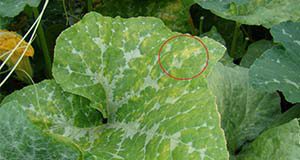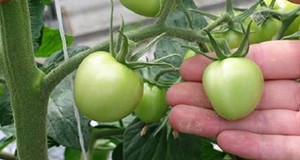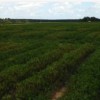This seven-page fact sheet includes a summary of various fungicide spray programs for fungal disease control of early leaf spot, late leaf spot, and white mold/stem rot of peanut in 2012-2016 on-farm trials in Hamilton County. Written by K.W. Wynn, N.S. Dufault, and R.L. Barocco and published by the Plant Pathology Department.
http://edis.ifas.ufl.edu/pp334
Tag: Nicholas S. Dufault
Management of Cucurbit Downy Mildew in Florida

Cucurbit downy mildew is a major disase that affects over 40 species of cucurbits, like watermelon, muskmelon, cucumber, squash, and pumpkin. The classic sign of the disease is the presence of dark sporangia, a structure that holds developing spores, on the underside of infected leaves. As the disease progresses, it may lead to large necrotic areas that cause defoliation and a reduction of yield and marketable fruit. This nine-page fact sheet describes the symptoms and signs, epidemiology and disease cycle, host range and pathotypes, and the ways to manage cucurbit downy mildew. Written by Mason J. Newark, Mathews L. Paret, Nicholas S. Dufault, Pamela D. Roberts, Shouan Zhang, Gary E. Vallad, Josh Freeman, and Gene McAvoy, and published by the Plant Pathology Department.
http://edis.ifas.ufl.edu/pp325
“Candidatus Liberibacter solanacearum”: An Emerging Pathogen Infecting Potato and Tomato

A bacterium called “Candidatus Liberibacter solanacearum” infects potatoes and tomatoes, causing zebra chip in potatoes and psyllid yellows in tomatoes. These disease are highly destructive and have been known to reduce yields by up to 85%. “Ca. L. solanacearum” has been reported in several states, though it has not been detected in Florida, which is the second largest producer of tomatoes and seventh largest producer of potatoes in the US. This 9-page fact sheet covers the biology, distribution, symptoms, transmission, diagnosis, and management of the pathogen and its associated diseases. Written by Binoy Babu, Mathews L. Paret, Nicholas Dufault, and Carrie L. Harmon, and published by the UF Department of Plant Pathology, August 2015.
http://edis.ifas.ufl.edu/pp320
Carinata Production in Florida
 Brassica carinata is a promising oilseed crop with great potential for profitable cultivation in Florida. Its high oil content and favorable fatty acid profile make it suitable for the biofuel industry, especially as a biojet fuel. The UF/IFAS North Florida Research and Education Center (NFREC) in Quincy, Florida, has been working to identify advanced carinata genotypes that are high yielding (seed and oil), disease resistant, early maturing, and adapted to Florida. The work at NFREC is being done in conjunction with Agrisoma Biosciences Inc., a crop company that has the world’s largest collection of carinata germplasm. This 6-page fact sheet’s “Agronomic Management” section provides recommendations resulting from NFREC’s research. was written by C. M. Bliss, R. Seepaul, D. L. Wright, J. J. Marois, R. Leon, N. Dufault, S. George, and S. M. Olson, and published by the UF Department of Agronomy, December 2014.
Brassica carinata is a promising oilseed crop with great potential for profitable cultivation in Florida. Its high oil content and favorable fatty acid profile make it suitable for the biofuel industry, especially as a biojet fuel. The UF/IFAS North Florida Research and Education Center (NFREC) in Quincy, Florida, has been working to identify advanced carinata genotypes that are high yielding (seed and oil), disease resistant, early maturing, and adapted to Florida. The work at NFREC is being done in conjunction with Agrisoma Biosciences Inc., a crop company that has the world’s largest collection of carinata germplasm. This 6-page fact sheet’s “Agronomic Management” section provides recommendations resulting from NFREC’s research. was written by C. M. Bliss, R. Seepaul, D. L. Wright, J. J. Marois, R. Leon, N. Dufault, S. George, and S. M. Olson, and published by the UF Department of Agronomy, December 2014.
http://edis.ifas.ufl.edu/ag389
2013 Evaluation of In-Furrow and Foliar Fungicides for Disease Control in Peanut in Jay, Florida
 This 10-page fact sheet summarizes the 2013 in-furrow and foliar fungicide programs for control of early and late leaf spot and white mold (southern stem rot) of peanut in Jay, Florida. It shows the effectiveness of 13 fungicide programs for disease control, as compared to no treatment. This data represents only one year and one location, and readers are cautioned that test results should be considered over several locations and years before final conclusions are valid. Written by Darcy E. P. Telenko, John Atkins, and Nick Dufault, and published by the UF Department of Plant Pathology, January 2014.
This 10-page fact sheet summarizes the 2013 in-furrow and foliar fungicide programs for control of early and late leaf spot and white mold (southern stem rot) of peanut in Jay, Florida. It shows the effectiveness of 13 fungicide programs for disease control, as compared to no treatment. This data represents only one year and one location, and readers are cautioned that test results should be considered over several locations and years before final conclusions are valid. Written by Darcy E. P. Telenko, John Atkins, and Nick Dufault, and published by the UF Department of Plant Pathology, January 2014.
http://edis.ifas.ufl.edu/pp310
Integrated Disease Management for Vegetable Crops in Florida (PP193/PP111)
 Integrated Pest Management (IPM) as applied to vegetable diseases means using all the tactics available to the grower (cultural, biological, host-plant resistance, field scouting, chemical) that provide acceptable yield and quality at the least cost and are compatible with the tenets of environmental stewardship. This 6-page fact sheet was written by Mathews Paret, Nick Dufault, Tim Momol, Jim Marois, and Steve Olson, and published by the UF Department of Plant Pathology, August 2012.
Integrated Pest Management (IPM) as applied to vegetable diseases means using all the tactics available to the grower (cultural, biological, host-plant resistance, field scouting, chemical) that provide acceptable yield and quality at the least cost and are compatible with the tenets of environmental stewardship. This 6-page fact sheet was written by Mathews Paret, Nick Dufault, Tim Momol, Jim Marois, and Steve Olson, and published by the UF Department of Plant Pathology, August 2012.
http://edis.ifas.ufl.edu/pp111
Management of Gummy Stem Blight (Black Rot) in Cucurbits in Florida (PP280)
Gummy stem blight (GSB) is a major disease of many cucurbits, including watermelon, cantaloupe, cucumber, pumpkin, squash, muskmelon, and other melons. The disease is also known as black rot due to its characteristic appearance on infected fruits. Learn the symptoms, causal agent and disease spread, and fungicides labeled for use in Florida. This 9-page fact sheet was written by Mathews L. Paret, Nicholas S. Dufault, and Stephen M. Olson , and published by the UF Department of Plant Pathology, January 2011.
http://edis.ifas.ufl.edu/pp280
